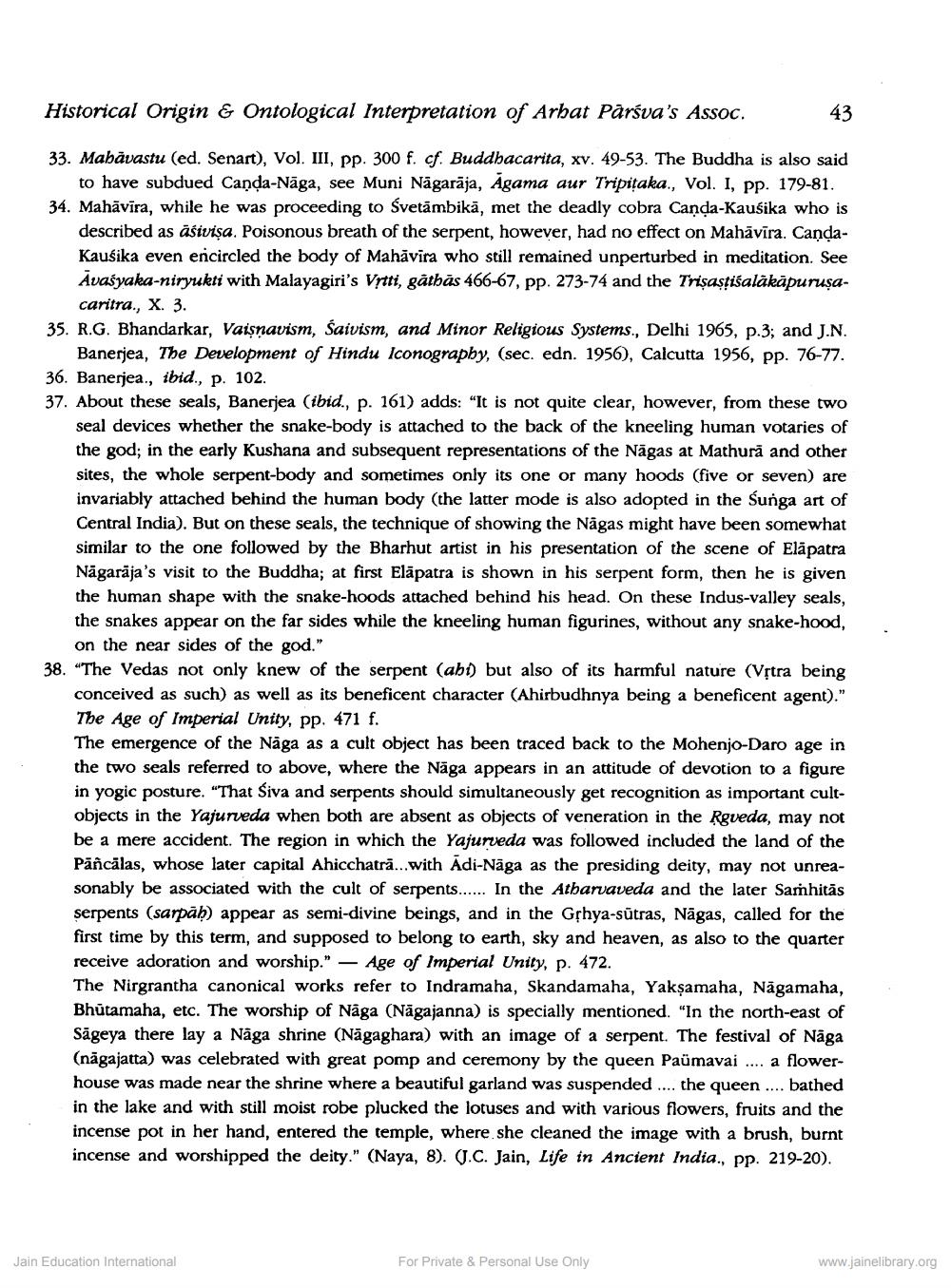________________
Historical Origin & Ontological Interpretation of Arhat Pārsva's Assoc.
43
33. Mabävastu (ed. Senart), Vol. III, pp. 300 f. cf. Buddhacarita, xv. 49-53. The Buddha is also said
to have subdued Canda-Nāga, see Muni Nāgarāja, Agama aur Tripitaka., Vol. I, pp. 179-81. 34. Mahāvīra, while he was proceeding to Svetāmbikā, met the deadly cobra Canda-Kausika who is
described as āśivisa. Poisonous breath of the serpent, however, had no effect on Mahāvīra. CandaKausika even encircled the body of Mahāvira who still remained unperturbed in meditation. See Avaśyaka-niryukti with Malayagiri's Vrtti, gātbās 466-67, pp. 273-74 and the Trişastišalākāpurusa
caritra., X. 3. 35. R.G. Bhandarkar, Vaisnavism, Saivism, and Minor Religious Systems., Delhi 1965, p.3; and J.N.
Banerjea, The Development of Hindu Iconography, (sec. edn. 1956), Calcutta 1956, pp. 76-77. 36. Banerjea., ibid., p. 102. 37. About these seals, Banerjea (ibid., p. 161) adds: “It is not quite clear, however, from these two
seal devices whether the snake-body is attached to the back of the kneeling human votaries of the god; in the early Kushana and subsequent representations of the Nāgas at Mathurā and other sites, the whole serpent-body and sometimes only its one or many hoods (five or seven) are invariably attached behind the human body (the latter mode is also adopted in the Sunga art of Central India). But on these seals, the technique of showing the Nägas might have been somewhat similar to the one followed by the Bharhut artist in his presentation of the scene of Elāpatra Nāgarāja's visit to the Buddha; at first Elāpatra is shown in his serpent form, then he is given the human shape with the snake-hoods attached behind his head. On these Indus-valley seals, the snakes appear on the far sides while the kneeling human figurines, without any snake-hood,
on the near sides of the god." 38. "The Vedas not only knew of the serpent (abt) but also of its harmful nature (Vţtra being
conceived as such) as well as its beneficent character (Ahirbudhnya being a beneficent agent)." The Age of Imperial Unity, pp. 471 f. The emergence of the Nāga as a cult object has been traced back to the Mohenjo Daro age in the two seals referred to above, where the Nāga appears in an attitude of devotion to a figure in yogic posture. "That Siva and serpents should simultaneously get recognition as important cultobjects in the Yajurveda when both are absent as objects of veneration in the Rgveda, may not be a mere accident. The region in which the Yajurveda was followed included the land of the Pāñcalas, whose later capital Ahicchatrā...with Adi-Nāga as the presiding deity, may not unreasonably be associated with the cult of serpents...... In the Atharvaveda and the later Samhitās serpents (sarpāh) appear as semi-divine beings, and in the Gphya-sútras, Nāgas, called for the first time by this term, and supposed to belong to earth, sky and heaven, as also to the quarter receive adoration and worship." — Age of Imperial Unity, p. 472. The Nirgrantha canonical works refer to Indramaha, Skandamaha, Yakşamaha, Nāgamaha, Bhūtamaha, etc. The worship of Naga (Nägajanna) is specially mentioned. "In the north-east of Sāgeya there lay a Näga shrine (Nägaghara) with an image of a serpent. The festival of Nāga (nāgajatta) was celebrated with great pomp and ceremony by the queen Paümavai .... a flowerhouse was made near the shrine where a beautiful garland was suspended .... the queen .... bathed in the lake and with still moist robe plucked the lotuses and with various flowers, fruits and the incense pot in her hand, entered the temple, where she cleaned the image with a brush, burnt incense and worshipped the deity." (Naya, 8). (J.C. Jain, Life in Ancient India., pp. 219-20).
Jain Education International
For Private & Personal Use Only
www.jainelibrary.org




